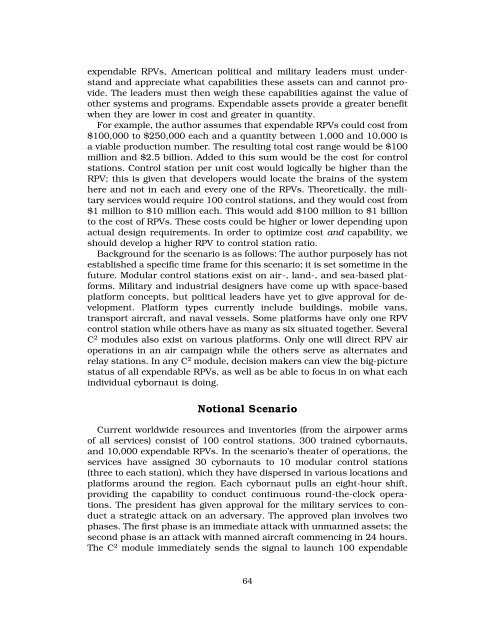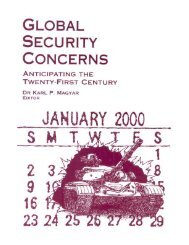Expendable Remotely Piloted Vehicles for Strategic Offensive ...
Expendable Remotely Piloted Vehicles for Strategic Offensive ...
Expendable Remotely Piloted Vehicles for Strategic Offensive ...
Create successful ePaper yourself
Turn your PDF publications into a flip-book with our unique Google optimized e-Paper software.
expendable RPVs, American political and military leaders must understandand appreciate what capabilities these assets can and cannot provide.The leaders must then weigh these capabilities against the value ofother systems and programs. <strong>Expendable</strong> assets provide a greater benefitwhen they are lower in cost and greater in quantity.For example, the author assumes that expendable RPVs could cost from$100,000 to $250,000 each and a quantity between 1,000 and 10,000 isa viable production number. The resulting total cost range would be $100million and $2.5 billion. Added to this sum would be the cost <strong>for</strong> controlstations. Control station per unit cost would logically be higher than theRPV; this is given that developers would locate the brains of the systemhere and not in each and every one of the RPVs. Theoretically, the militaryservices would require 100 control stations, and they would cost from$1 million to $10 million each. This would add $100 million to $1 billionto the cost of RPVs. These costs could be higher or lower depending uponactual design requirements. In order to optimize cost and capability, weshould develop a higher RPV to control station ratio.Background <strong>for</strong> the scenario is as follows: The author purposely has notestablished a specific time frame <strong>for</strong> this scenario; it is set sometime in thefuture. Modular control stations exist on air-, land-, and sea-based plat<strong>for</strong>ms.Military and industrial designers have come up with space-basedplat<strong>for</strong>m concepts, but political leaders have yet to give approval <strong>for</strong> development.Plat<strong>for</strong>m types currently include buildings, mobile vans,transport aircraft, and naval vessels. Some plat<strong>for</strong>ms have only one RPVcontrol station while others have as many as six situated together. SeveralC 2 modules also exist on various plat<strong>for</strong>ms. Only one will direct RPV airoperations in an air campaign while the others serve as alternates andrelay stations. In any C 2 module, decision makers can view the big-picturestatus of all expendable RPVs, as well as be able to focus in on what eachindividual cybornaut is doing.Notional ScenarioCurrent worldwide resources and inventories (from the airpower armsof all services) consist of 100 control stations, 300 trained cybornauts,and 10,000 expendable RPVs. In the scenario’s theater of operations, theservices have assigned 30 cybornauts to 10 modular control stations(three to each station), which they have dispersed in various locations andplat<strong>for</strong>ms around the region. Each cybornaut pulls an eight-hour shift,providing the capability to conduct continuous round-the-clock operations.The president has given approval <strong>for</strong> the military services to conducta strategic attack on an adversary. The approved plan involves twophases. The first phase is an immediate attack with unmanned assets; thesecond phase is an attack with manned aircraft commencing in 24 hours.The C 2 module immediately sends the signal to launch 100 expendable64






